|
Home » Sponsored » Pi Speakers » H290C Horn/Waveguide (Upgrade for the obsolete Eminence H290)
| Re: H290C Horn/Waveguide [message #73258 is a reply to message #72816] |
Thu, 12 July 2012 08:08   |
 |
 Wayne Parham
Wayne Parham
Messages: 18678
Registered: January 2001
|
Illuminati (33rd Degree) |
|
|
Measurements
all measurements taken using DE250 driver
mounted on infinite baffle, i.e. half-space
drive signal 8.4v
microphone distance 3M
Impedance

The impedance graph shows first 1/4λ mode is around 800Hz, and 1/2λ about 1.6kHz. You can also see it in the response curve below.
All horns like this (conical, quadratic, oblate spheroidal) have a peak at the 1/4λ mode. The dimensions of the H290C place that peak just below the passband, which I find an attractive configuration.
Its pure oblate spheroidal flare profile sets its length and mouth size based on its tangential wall angle and throat size. These are fixed dimenisions, set by its geometry, as discussed earlier in this thread. A conical or OS flare has to be at least as long as half its width to achieve the right mouth size to support a 90° pattern. You can't create a right triangle with any other dimensions.
On-axis response
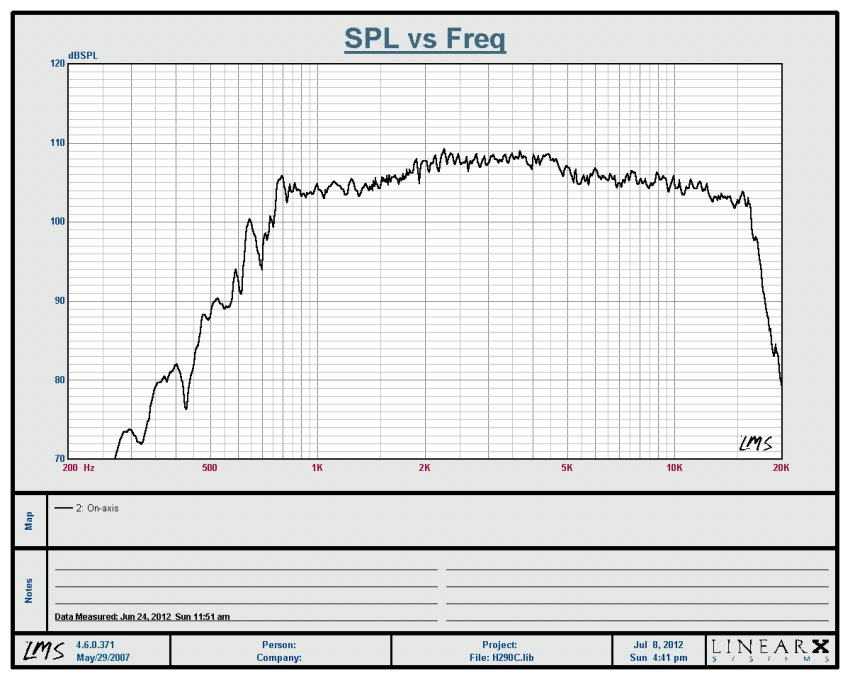
Devices like this have a peak at cutoff, followed by reduced output through the first octave. That's because they don't really provide good acoustic loading down low. They start becoming most efficient around 1/2λ and above.
That's why the π crossover provides a method for setting specific damping in the crossover region, as well as for setting the top-octave compensation for mass-rolloff. The values chosen for the π pad set the bottom-octave level (by virtue of crossover filter Q) and top-octave level (by virtue of attenuator bypass capacitor and/or shunt resistor and the rising impedance of the voice coil). So this very versatile crossover configuration is perfect for waveguides.
Horizontal Response Curves, every 10° through a 180° arc
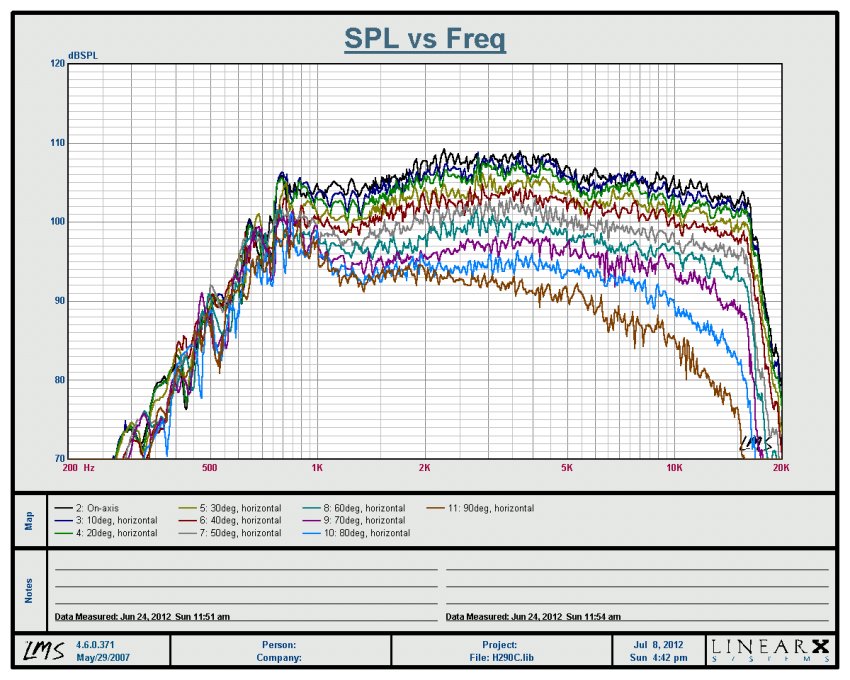
Horizontal off-axis response is excellent, very uniform through the coverage pattern, and well-behaved outside the pattern too.
Horizontal Contour Chart (Directivity Sonogram)
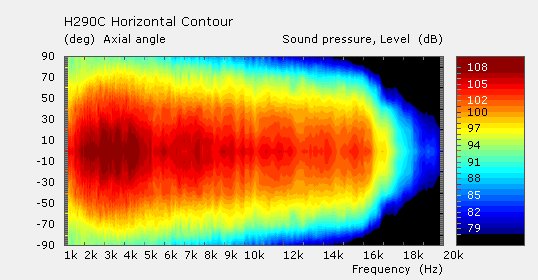
Viewing the horizontal beamwidth using a sonogram, you can see that energy distribution is very uniform. However, you may also notice that at low frequencies, the beamwidth doesn't widen as you might expect, it actually becomes more narrow. This is called waistbanding, a narrowing of the beam before the pattern widens at low frequencies below 1kHz.
The H290C waveguide is optimized to reduce internal reflections through the passband, and to do this requires the oblate spheroidal flare profile remain pure, without much of a secondary flare widening at the mouth. This approach trades a slight amount of waistbanding for reduced internal reflections, smoother response and improved overall sound quality.
This is a useful tradeoff because waveguide beamwidth narrows in the crossover overlap region where it blends with the other sound source. The two sources contribute to the overall summed response in all axes, and this provides the loudspeaker designer an easy solution path for uniform directivity.
The chart above shows the energy produced at all horizontal angles without normalization. Being denormalized, you see the actual energy distribution at various angles, not the directivity as referenced to the on-axis level. If we want to see that, we must normalize the curves to the on-axis chart, as shown below:
Horizontal Contour Chart (Normalized to the on-axis curve)
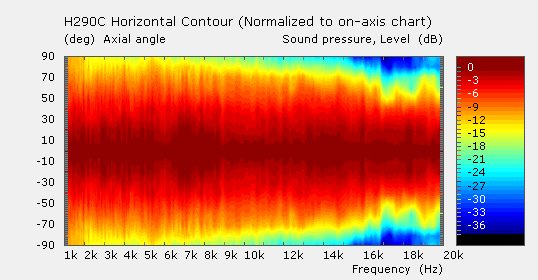
This shows directivity is constant through the passband. The definition of beamwidth is angles where the SPL is -6dB from the on-axis level, which can be seen to be constant at 90° (+/-45°).
It is easier to see the -6dB points if we stratify the contour gradient at 6dB rather than every 1dB. This shows the beamwidth angles very clearly:
Horizontal Contour Chart (Stratified at 6dB increments)
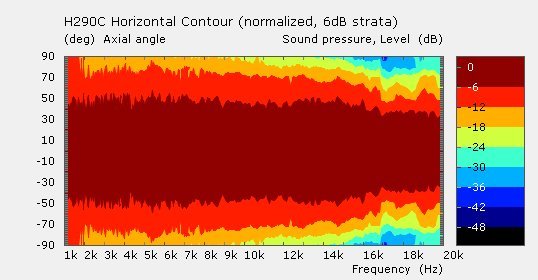
Now to the verticals.
Vertical Response Curves, every 10° through a 180° arc
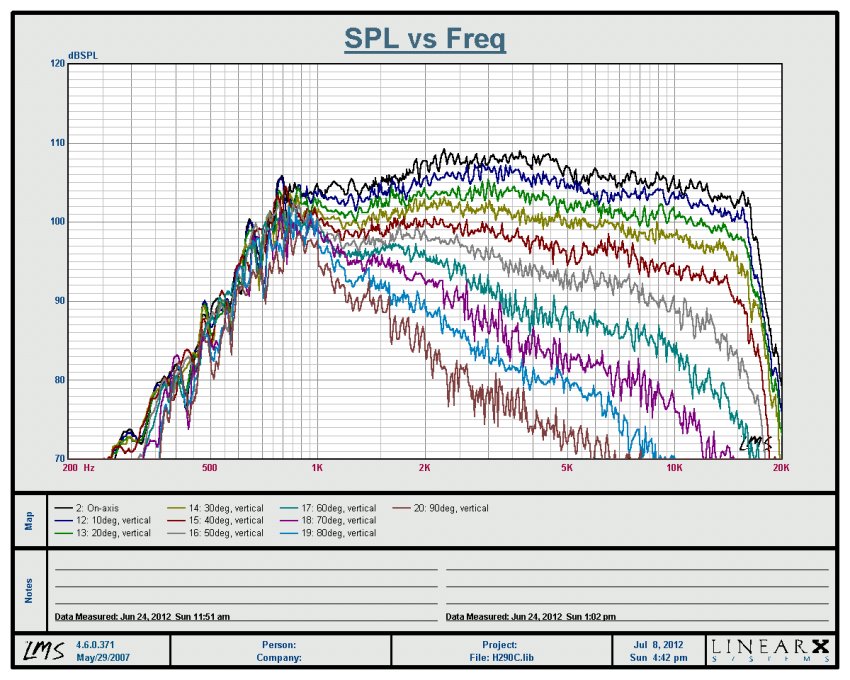
Naturally, the output at large off-axis angles is reduced considerably in the vertical. This is exactly what we want. It cannot maintain directivity control all the way down to 1kHz like it does in the horizontal axis - the horn is too small in the vertical dimension. But it is able to start gaining directivity control around 2kHz, which is excellent for a horn of this size. It also manages to collapse directivity gracefully, largely due to the mouth roundover and baffle mounting.
As you can see, directivity smoothly collapses as it begins to get control around 2kHz. By 3kHz, it is around 50°, and it remains pretty constant above that point.
Vertical Contour Chart (Directivity Sonogram)
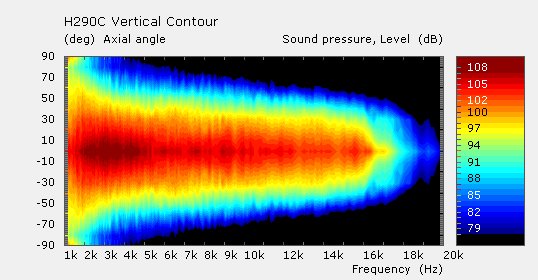
Again, we are viewing the energy produced at all vertical angles without normalization. Being denormalized, you see the actual energy distribution at various angles, not the directivity as referenced to the on-axis level. If we want to see that, we must normalize the curves to the on-axis chart:
Vertical Contour Chart (Normalized to the on-axis curve)
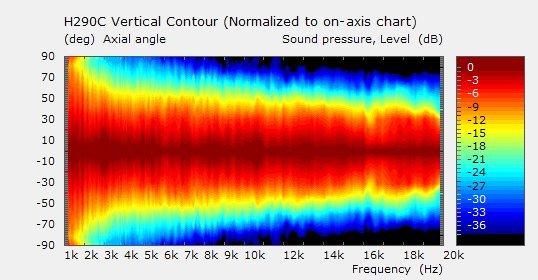
This shows vertical beamwidth is constant from 3kHz upwards through the passband. Again, the definition of beamwidth is angles where the SPL is -6dB from the on-axis level, which can be seen to be constant around 50° (+/-25°).
It is easier to see the -6dB points if we stratify the contour gradient at 6dB rather than every 1dB. This shows the beamwidth angles very clearly:
Vertical Contour Chart (Stratified at 6dB increments)
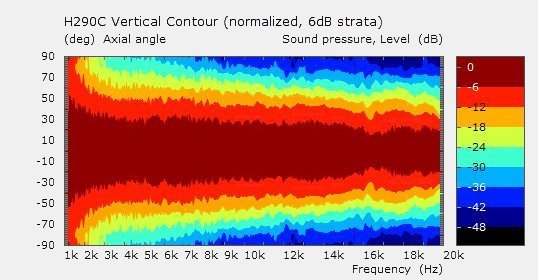
|
|
|
|
 |
|
H290C Horn/Waveguide
By: santos on Tue, 27 March 2012 03:48 |
 |
|
Re: H290C Horn/Waveguide
|
 |
|
Re: H290C Horn/Waveguide
By: Maxjr on Thu, 29 March 2012 13:26 |
 |
|
Re: H290C Horn/Waveguide
|
 |
|
Re: H290C Horn/Waveguide
|
 |
|
Re: H290C Horn/Waveguide
|
 |
|
Re: H290C Horn/Waveguide
By: Maxjr on Thu, 17 May 2012 16:37 |
 |
|
Re: H290C Horn/Waveguide
|
 |
|
Re: H290C Horn/Waveguide
|
 |
|
Re: H290C Horn/Waveguide
|
 |
|
Re: H290C Horn/Waveguide
|
 |
|
Re: H290C Horn/Waveguide
|
 |
|
Re: H290C Horn/Waveguide
By: zheka on Fri, 27 July 2012 19:58 |
 |
|
Re: H290C Horn/Waveguide
|
 |
|
Re: H290C Horn/Waveguide
By: zheka on Sun, 29 July 2012 08:32 |
 |
|
Re: H290C Horn/Waveguide
|
 |
|
Re: H290C Horn/Waveguide
By: mantha3 on Tue, 31 July 2012 11:17 |
 |
|
Re: H290C Horn/Waveguide
|
 |
|
Re: H290C Horn/Waveguide
By: mantha3 on Tue, 31 July 2012 14:28 |
 |
|
Re: H290C Horn/Waveguide
By: blvdre on Tue, 31 July 2012 15:35 |
 |
|
Re: H290C Horn/Waveguide
|
 |
|
Re: H290C Horn/Waveguide
|
 |
|
Re: H290C Horn/Waveguide
By: Maxjr on Thu, 16 August 2012 07:42 |
 |
|
Re: H290C Horn/Waveguide
|
 |
|
Re: H290C Horn/Waveguide
By: Maxjr on Thu, 16 August 2012 14:11 |
 |
|
Re: H290C Horn/Waveguide
By: gofar99 on Sat, 18 August 2012 14:35 |
 |
|
Re: H290C Horn/Waveguide
By: Maxjr on Wed, 22 August 2012 22:48 |
 |
|
Re: H290C Horn/Waveguide
|
 |
|
Re: H290C Horn/Waveguide
|
 |
|
Re: H290C Horn/Waveguide
|
 |
|
Re: H290C Horn/Waveguide
|
 |
|
Re: H290C Horn/Waveguide
|
 |
|
Re: H290C Horn/Waveguide
|
 |
|
Re: H290C Horn/Waveguide
|
 |
|
Re: H290C Horn/Waveguide
|
 |
|
Re: H290C Horn/Waveguide
|
 |
|
Re: H290C Horn/Waveguide
By: rkeman on Thu, 21 March 2013 14:20 |
 |
|
Re: H290C Horn/Waveguide
|
 |
|
Re: H290C Horn/Waveguide
|
 |
|
Re: H290C Horn/Waveguide
By: zheka on Tue, 23 April 2013 09:59 |
 |
|
Re: H290C Horn/Waveguide
|
 |
|
Re: H290C Horn/Waveguide
By: zheka on Tue, 23 April 2013 11:03 |
 |
|
Re: H290C Horn/Waveguide
|
 |
|
Re: H290C Horn/Waveguide
By: zheka on Tue, 23 April 2013 11:20 |
 |
|
Re: H290C Horn/Waveguide
|
 |
|
Re: H290C Horn/Waveguide
|
 |
|
Re: H290C Horn/Waveguide
|
 |
|
Re: H290C Horn/Waveguide - closest equiv. in 1.5" or 2"?
By: tubino on Thu, 17 September 2020 14:41 |
 |
|
Re: H290C Horn/Waveguide - closest equiv. in 1.5" or 2"?
|
 |
|
Re: H290C Horn/Waveguide - closest equiv. in 1.5" or 2"?
By: tubino on Fri, 18 September 2020 06:40 |
 |
|
Re: H290C Horn/Waveguide
|
Goto Forum:
Current Time: Fri Apr 26 01:56:28 CDT 2024
|







